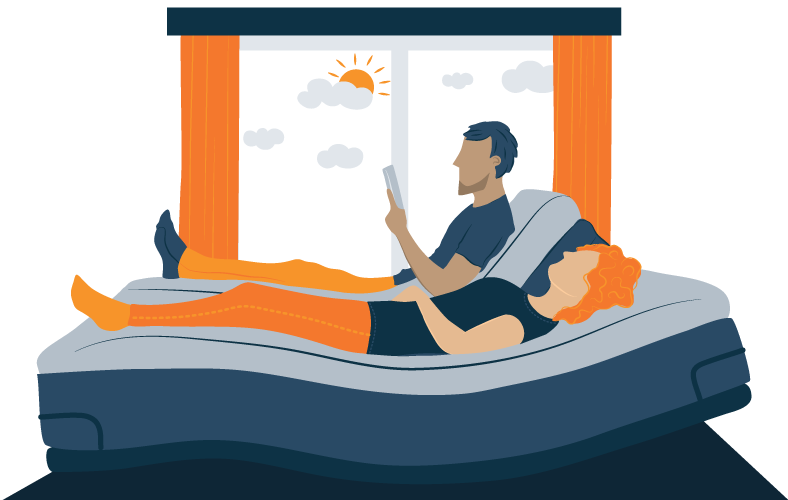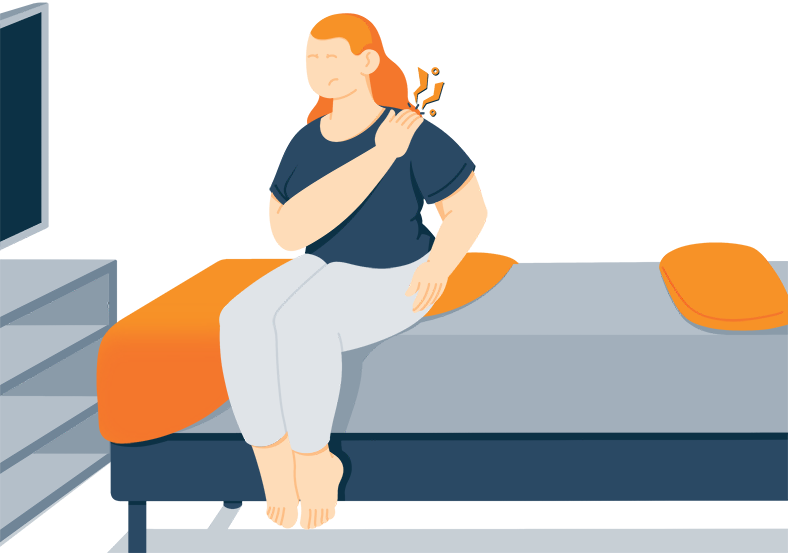For people with experience back pain, the right bed can make all the difference. Back pain affects every part of your life, from trying to get through your day to the way you sleep at night. If you’re experiencing back pain, how you sleep at night plays a huge role in your pain levels the following day.
Switching to an adjustable bed may be the solution that you’re seeking. Below, we’ll break down exactly how an adjustable bed can add to your comfort and help with your discomfort. We’ll also look at the most important things to know before you buy.
How an Adjustable Bed Alleviates Back Pain
Supports Your Back
Sleeping on an incline with an adjustable bed allows you to rest at night with consistent support from your mattress. Many people try to raise their head and shoulders, or their knees, with pillows or blankets. While this method may feel good at first, the uneven support could worsen your back pain over time.
Using an adjustable bed with a fixed incline is more likely to provide your back with proper support and alignment all through the night.
You can also find mattresses to alleviate back pain in our best mattress for back pain guide.
Reduces Joint Compression
Sometimes flat mattresses can worsen back problems by not correctly aligning your spine, or they put pressure on your joints. An adjustable bed can allow you to find the position that provides the best pressure relief for your needs.
Experts often recommend adjustable beds for people who have had back surgery[1] because the incline options for the head and feet can alleviate pressure in a way that regular beds cannot.
Sleeping on an Incline
Altering your sleep position with an adjustable mattress can have several health benefits. People with lower back pain could find relief by sleeping on a slight incline[2], and for extra relief, they could elevate their knees. Elevating both your upper back and knees slightly changes where your body experiences pressure during sleep, taking the weight off of your spine and distributing it more evenly to reduce pain.
Sleeping on an incline may also help with sleep apnea and snoring. A 2017 study[3] found that tilting sleepers only 7.5 degrees can decrease obstructive sleep apnea severity by 31.8 percent. A 2021 study[4] discovered that having the head of the bed elevated may improve GERD symptoms. Raising your head by 30 degrees may also prevent glaucoma from progressing. A 2018 study[5] shows that sleeping like this reduces the pressure inside the eye.
Find Out More: Inclined Bed Therapy
Back Conditions That May Benefit From an Adjustable Bed
Sleepers who experience specific back conditions such as osteoarthritis and sciatica may find that an adjustable bed works better to alleviate the symptoms of these conditions than a flat mattress can. Manufacturers design adjustable beds specifically for people with medical conditions who cannot get proper rest from traditional beds.
Osteoarthritis
Osteoarthritis is a common type of arthritis that comes with aging and the general wear and tear of joint cartilage. Sleeping on an adjustable bed won’t reverse the effects of osteoarthritis, but it can help you manage the accompanying pain.
An adjustable bed with a firm memory foam mattress or latex mattress that has received high marks in pressure relief could keep the pain from osteoarthritis at bay and allow you to sleep better through the night. Adjustable beds may also benefit those who experience arthritis of all kinds.
Interested in exploring further? See our complete guide to the best mattress for arthritis here.
Spinal Stenosis
If you experience back pain while walking that goes away when you sit down, you may be experiencing the side effects of spinal stenosis. Spinal stenosis is the result of the narrowing of the spaces in the spine.
People can usually reduce spinal stenosis pain by leaning forward rather than standing or lying straight. With an adjustable mattress, people who have spinal stenosis can find support in an upright position that reduces the pressure on the vertebrae that cause this discomfort.
People with spinal stenosis may feel the most benefit from sleeping in an adjustable bed paired with a bed made of supportive memory foam or latex.
See Our Full Guide: Best Mattress for Spinal Stenosis
Degenerative Spondylolisthesis
Degenerative spondylolisthesis is when a vertebra slips out of place and rests against the vertebra below it. Often, the disks between the vertebrae and the facet joints, which cushion your vertebrae, lose fluid and wear down. The compression or pinching of the nerve roots coming out of the spinal canal can cause pain in your legs.
This degenerative condition is more common as individuals age into their 50s and beyond, and it’s more common in women than in men. Sleeping on a flat mattress can exacerbate the pain from degenerative spondylolisthesis. An adjustable bed may allow someone with this condition to find a sleeping posture that limits their discomfort.
Sciatica
The sciatic nerves connect the base of your spine to each foot, conjoining five nerve roots before passing deep through each buttock and down the back of each thigh. People with sciatica often experience radiating pain that moves through this path, causing discomfort, especially in the back of each leg.
Sciatic pain usually resides in the buttocks and legs, so sleepers with sciatica may benefit more when raising their knees with an adjustable mattress. Knee elevation with consistent support can reduce the pain from the sciatic nerve.
A mattress with excellent pressure relief and weight support may help those who experience sciatica.
Check Out Our Guide: Best Mattress for Sciatica
Herniated Disc
A herniated disc can cause pain that disrupts not only your day-to-day routine but your sleep.
The majority of the time, the herniation is in the lower back, though some people may experience it in other areas due to their level of activity or the types of exercises they enjoy.
A mattress with good pressure relief that keeps your spine in a neutral position is ideal for those with a herniated disc.
Check Out Our Guide: Best Mattresses for Herniated Discs
Things to Consider Before Purchasing an Adjustable Bed to Relieve Back Pain
Before you purchase an adjustable bed to treat your back pain, there are a few things to consider to ensure that you find the right combination of mattress and adjustable frame for your needs.
- Mattress Type – Memory foam and latex mattresses work best because of their flexible structure. They can withstand the regular bending of an adjustable frame. Hybrid mattresses may also work. Each type of mattress will offer varying levels of pressure relief, as well as cooling features and spinal alignment. We don’t recommend using an innerspring mattress with an adjustable frame as the coil structure doesn’t offer much flexibility, and the bending will reduce the mattress’s lifespan.
See Our Full Guide: Best Mattress for Adjustable Beds
- Bed Size – You can use an adjustable frame with any bed size, so your choice of width is a personal one. Most recommended adjustments are for back sleeping. Adjustable bed frames are generally the same size as the traditional frame for each mattress size. However, because of the articulating head and foot machinery, you may want to account for some extra space in your room to allow these pieces to move freely and not affect any other furniture in the room.
- Weight and Frames – Adjustable bed frames are typically heavier than traditional beds because of the additional machinery. They can also have specific weight limits. Make sure that when you choose your frame, you confirm that it’s appropriate for the room you’d like to use it in and that it can support your weight. The other weight-related issue to consider is making sure that you choose a mattress that will best support your weight, especially in a back-sleeping position.
What is the Best Adjustable Bed Position for Back Pain?
If you have a medical condition, your doctor may prescribe an ideal sleeping position for you.
Most people with spinal conditions find that back-sleeping works well when they adjust their beds to contour to their spine’s natural ‘S’ shape, which provides extra support for their spine, hips, and knees.
If you find relief in a seated or slightly reclined position, you can benefit from elevating your upper body. Side sleepers can also slightly raise both the head and foot sections to simulate the fetal position, reducing tension and supporting the spine.
Get More Info: Zero Gravity Sleep Position Benefits
Frequently Asked Questions
Can adjustable beds cause lower back pain?
An adjustable bed can cause lower back pain if you don’t use it the right way. Although most adjustable beds are created to relieve this pain and pressure, improper use that doesn’t fit your condition may worsen things rather quickly. For example, people with degenerative spondylolisthesis benefit from elevating the upper body. However, too much elevation can make things worse by putting too much pressure on the affected area.
Is it good for your back to sleep on an adjustable bed?
Sleeping on an adjustable bed can be good for your bed because a slight upper body incline and elevated knees promote the spine’s natural curve. This can also reduce inflammation, stimulate blood circulation, and may help with GERD and sleep apnea symptoms. Even side sleeping on an adjustable bed can be beneficial for spine alignment, depending on the degree of elevation.
Do doctors recommend adjustable beds?
Doctors may recommend adjustable beds to people with certain health conditions, but this depends on each patient and their individual circumstances. An adjustable bed can help with neck, back, and spine issues while also helping with other sleep-related issues like snoring and sleep apnea. In many cases, a physician may bring up an adjustable bed as a suggestion for alleviating discomfort rather than a mandatory measure for treatment.
What are the disadvantages of an adjustable bed?
Most disadvantages of an adjustable bed are related to its size and weight. These beds are typically much heavier and bulkier than regular models. On top of that, they may be noisier due to their moving parts. Some people, like stomach and combination sleepers, might find it uncomfortable to sleep in an elevated position even if the incline is small. These beds are also typically much more expensive than regular frames.
Conclusion
If you regularly experience back pain that gets worse by sleeping on a flat surface, you may want to consider investing in an adjustable bed and a foam or latex mattress. Doctors may recommend adjustable bed frames to those who experience specific medical conditions associated with back pain, as well as other medical conditions such as sinus or respiratory issues or acid reflux. Talk to your doctor about how you might benefit from an adjustable bed.
An adjustable bed and compatible mattress may be an investment, but they could be a lifesaver if you have trouble sleeping because of your back pain.

Jill Zwarensteyn
Editor
About Author
Jill Zwarensteyn is the Editor for Sleep Advisor and a Certified Sleep Science Coach. She is enthusiastic about providing helpful and engaging information on all things sleep and wellness.
Combination Sleeper
Sources:
- “Should You Get an Adjustable Bed to Help Alleviate Your Back Pain?”. Orthopedic and Laser Spine Surgery. 2021.
- “The Best Sleeping Positions for Lower Back Pain”. Reid Health. Webpage accessed October 31, 2024.
- Fabrício de Barros Souza, Fábio José., Rodrigues Genta, Pedro. et. al. “The influence of head-of-bed elevation in patients with obstructive sleep apnea”. Sleep and Breathing. 2017.
- Albarqouni, Loai., Moynihan, Ray., et. al. “Head of bed elevation to relieve gastroesophageal reflux symptoms: a systematic review”. BMC Family Practice. 2021.
- Sedgewick, Jeffrey H., Sedgewick, Justin A., et. al. “Effects of different sleeping positions on intraocular pressure in secondary open-angle glaucoma and glaucoma suspect patients”. Clinical Ophthalmology. 2018.




